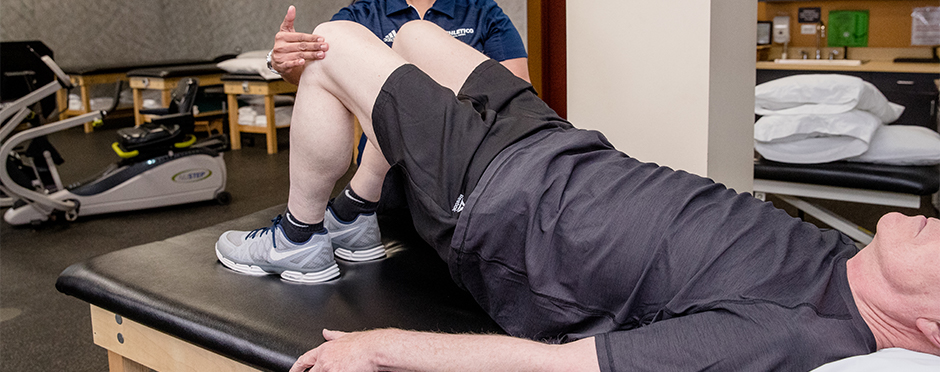
What to Know about the Male Pelvic Floor
1 CommentAt a recent patient evaluation, I read a prescription that stated the patient needed physical therapy for his “pubic floor.” I asked the patient if he meant pelvic floor and he confirmed that was what his wife had told him. This basically sums up how we as men view our pelvic floor, we are not cognizant it exists.
Females are much more aware of their pelvic floor due to life events like child birth. As men, we typically only pay attention to these muscles when there is dysfunction like weakness or musculature tightness, which may be accompanied by symptoms of pain or urinary issues. By being aware of these muscles and how they work, men can help to prevent future health problems. Read below to learn more about the male pelvic floor.
Pelvic Floor Function
The men’s health/pelvic floor patient population is diverse, as it can range from a 20 year-old with pelvic pain to a 75 year-old post prostatectomy with involuntary leakage issues known as incontinence. Each and every patient, no matter what their diagnosis, needs to understand the pelvic floor musculature, and that the pelvic floor muscles are just like every other muscle in the body.
The pelvic floor serves many functions including: bowel and bladder function, support for internal organs and sexual function. The pelvic floor is made up of a fibromuscular structure that is composed of the pelvic diaphragm and the muscles of the perineal pouch. The muscles sit at the bottom of the pelvis and have to work with the sphincters to relax for normal bowel and bladder function, yet stay contracted to keep all the contents in the pelvis from escaping.
Men who are experiencing pelvic pain and urinary issues should consider seeking treatment for their pelvic floor. While urinary incontinence is involuntary leakage accompanied by or immediately preceding urination, men should also be aware of stress incontinence, which is defined as involuntary leakage during physical exertion, coughing or sneezing. Both of these conditions, as well as pelvic pain, can be treated with physical therapy.
Physical Therapy for the Pelvic Floor
Rehabilitation of the pelvic floor is very similar to the treatment of other musculoskeletal problems in the body. The goal of treatment is to loosen up tight muscles by addressing trigger points, and then improve the strength and neuromuscular control of the musculature. The pelvic floor is very much like the cervical spine, as muscles are susceptible to tightness, which eventually manifests to pain. Tightness can be a result of increased stress or trauma to the area. Research has consistently found a strong correlation between stress and increased pelvic floor contractions1.
Physical therapy treatment for the pelvic floor typically includes manual therapy and trigger point release to the muscles to reduce hypertonicity. Other treatments may include biofeedback and down training, which provides feedback to the patient on how to relax their pelvic floor. Treatment will progress to improving the sequencing and muscle firing of the pelvic floor muscles as well as improve their coordination with surrounding hip and lumbopelvic core musculature. Research shows that treatment for pelvic floor conditions can be extremely effective in reducing pain and improving continence, as well as can have a positive impact on quality of life!2
If you think that you may benefit from men’s pelvic floor therapy, please schedule a free assessment with one of our specialized providers. These issues are often times easily corrected so don’t wait any longer suffering from pain or incontinence.
Athletico is now offering appointments in-clinic or virtually through telehealth. Request your free assessment using the button below.
Click to Schedule a Free Assessment
The Athletico blog is an educational resource written by Athletico employees. Athletico bloggers are licensed professionals who abide by the code of ethics outlined by their respective professional associations. The content published in blog posts represents the opinion of the individual author based on their expertise and experience. The content provided in this blog is for informational purposes only, does not constitute medical advice and should not be relied on for making personal health decisions.
References:
1. Anderson, Rodney U. “Integration of Myofascial Trigger Point Release and Paradoxical Relaxation Training Treatment of Chronic Pelvic Pain in Men.” The Journal of Urology. 174.1 (2005): 166-60. Web.
2. Ribeiro, Lucia S. “Long-Term Effect of Early Postoperative Pelvic Floor Biofeedback on Continence in Men Undergoing Radical Prostatectomy: A Prospective, Randomized, Controlled Trial.” The Journal

1 Comment
John Maddox
I like coming here because they will take care of me. They are very good at what they do